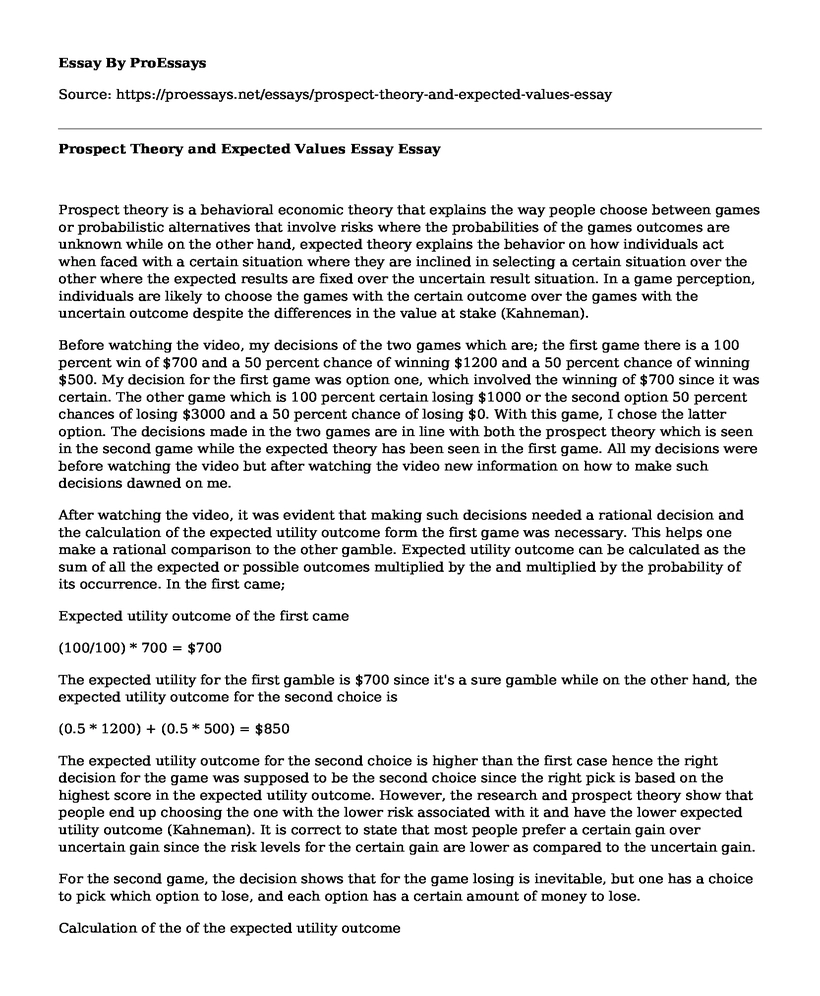Prospect theory is a behavioral economic theory that explains the way people choose between games or probabilistic alternatives that involve risks where the probabilities of the games outcomes are unknown while on the other hand, expected theory explains the behavior on how individuals act when faced with a certain situation where they are inclined in selecting a certain situation over the other where the expected results are fixed over the uncertain result situation. In a game perception, individuals are likely to choose the games with the certain outcome over the games with the uncertain outcome despite the differences in the value at stake (Kahneman).
Before watching the video, my decisions of the two games which are; the first game there is a 100 percent win of $700 and a 50 percent chance of winning $1200 and a 50 percent chance of winning $500. My decision for the first game was option one, which involved the winning of $700 since it was certain. The other game which is 100 percent certain losing $1000 or the second option 50 percent chances of losing $3000 and a 50 percent chance of losing $0. With this game, I chose the latter option. The decisions made in the two games are in line with both the prospect theory which is seen in the second game while the expected theory has been seen in the first game. All my decisions were before watching the video but after watching the video new information on how to make such decisions dawned on me.
After watching the video, it was evident that making such decisions needed a rational decision and the calculation of the expected utility outcome form the first game was necessary. This helps one make a rational comparison to the other gamble. Expected utility outcome can be calculated as the sum of all the expected or possible outcomes multiplied by the and multiplied by the probability of its occurrence. In the first came;
Expected utility outcome of the first came
(100/100) * 700 = $700
The expected utility for the first gamble is $700 since it's a sure gamble while on the other hand, the expected utility outcome for the second choice is
(0.5 * 1200) + (0.5 * 500) = $850
The expected utility outcome for the second choice is higher than the first case hence the right decision for the game was supposed to be the second choice since the right pick is based on the highest score in the expected utility outcome. However, the research and prospect theory show that people end up choosing the one with the lower risk associated with it and have the lower expected utility outcome (Kahneman). It is correct to state that most people prefer a certain gain over uncertain gain since the risk levels for the certain gain are lower as compared to the uncertain gain.
For the second game, the decision shows that for the game losing is inevitable, but one has a choice to pick which option to lose, and each option has a certain amount of money to lose.
Calculation of the of the expected utility outcome
100 percent to loss $1000 = -$1000 (expected utility outcome)
While the second gamble is
50 percent to lose $3000
50 percent to lose $0
The expected utility outcome of the second gamble is = -$1500 (expected utility outcome)
This shows that the expected utility outcome hence the appropriate choice based on the calculation favors the first gamble which as the least amount to loses. But the research on prospect theory shows that people go for the gamble with the least expected utility outcome and gives the nature of people where when confronted with loses. People will tend to take the riskier alternative, and this explains my first choice of gamble in the second game (Kahneman).
Works Cited
Kahneman, Daniel. Thinking, fast and slow. Macmillan, 2011.
Cite this page
Prospect Theory and Expected Values Essay. (2022, May 06). Retrieved from https://proessays.net/essays/prospect-theory-and-expected-values-essay
If you are the original author of this essay and no longer wish to have it published on the ProEssays website, please click below to request its removal:
- Industrial Relations Essay
- Digital Finance in Nigeria Paper Example
- Article Analysis Essay on the Impact of Employment of Foreign Workers
- Capitalism as Source of Contemporary World's Challenges - Essay Sample
- Free Trade: Removing Barriers to Encourage Trade - Essay Sample
- Essay on COVID-19: Unprecedented Global Economic Impact and Life Changes in Houston
- Essay Example on The Coronavirus Pandemic: Impact on Global Social & Economic Development







